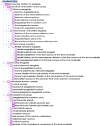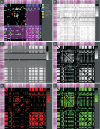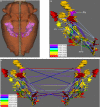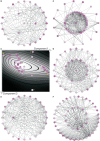The intrinsic connectome of the rat amygdala
- PMID: 23248583
- PMCID: PMC3518970
- DOI: 10.3389/fncir.2012.00081
The intrinsic connectome of the rat amygdala
Abstract
The connectomes of nervous systems or parts there of are becoming important subjects of study as the amount of connectivity data increases. Because most tract-tracing studies are performed on the rat, we conducted a comprehensive analysis of the amygdala connectome of this species resulting in a meta-study. The data were imported into the neuroVIISAS system, where regions of the connectome are organized in a controlled ontology and network analysis can be performed. A weighted digraph represents the bilateral intrinsic (connections of regions of the amygdala) and extrinsic (connections of regions of the amygdala to non-amygdaloid regions) connectome of the amygdala. Its structure as well as its local and global network parameters depend on the arrangement of neuronal entities in the ontology. The intrinsic amygdala connectome is a small-world and scale-free network. The anterior cortical nucleus (72 in- and out-going edges), the posterior nucleus (45), and the anterior basomedial nucleus (44) are the nuclear regions that posses most in- and outdegrees. The posterior nucleus turns out to be the most important nucleus of the intrinsic amygdala network since its Shapley rate is minimal. Within the intrinsic amygdala, regions were determined that are essential for network integrity. These regions are important for behavioral (processing of emotions and motivation) and functional (memory) performances of the amygdala as reported in other studies.
Keywords: amygdala; connectome; network analysis; rat brain; simulation; stereotaxic atlas; tract-tracing; visualization.
Figures










References
-
- Aggleton J. (2000). “The amygdala – what’s happened in the last decade?” in The Amygdala: A Functional Analysis, ed. Aggleton J. P. (New York: Oxford University Press; ), 2–29
-
- Arenas A., Fernández A., Gómez S. (2008). A complex network approach to the determination of functional groups in the neural system of C. elegans. Lect. Notes Comput. Sci. 5151, 9–1810.1007/978-3-540-92191-2_2 - DOI
-
- Baltz A., Kliemann L. (2004). “Spectral analysis,” in Network Analysis. Lecture Notes in Computer Science, Vol. 3418, eds Brandes U., Erlebach T. (Berlin: Springer; ), 373–416
LinkOut - more resources
Full Text Sources

